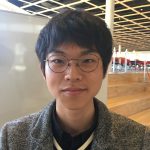Seiya Ishizawa
Home University: Tohoku University
Field of Study: Chemical Biology
Status: B3 Expected Graduation: March 2019
Research Host Lab: Prof. Zach Ball, Department of Chemistry
Research Project Title: “pGH Tag for Protein Purification” (PDF)
Why Nakatani RIES?
I decided to apply to this program because it was a rare chance to experience research at an American University while still an undergraduate. Through the research internship in a lab at Rice University, I believe that my academic knowledge will be broadened.
Furthermore, this internship will be an opportunity for me to learn what it’s like to work in a multi-ethnic environment and the changes taking place in the U.S. society under the Trump Administration.
Goals for the Summer
- Understand the culture of a U.S. research laboratory.
- Broaden my academic horizons.
- Obtain good understanding about multi-ethnic environment.
- Observe changes in the U.S. occurring from the administration change.
- Acquire English language ability to conduct debate in international environment.
Excerpts from Seiya’s Weekly Reports
- Week 01: Arrival in the U.S.
- Week 02: First Week in My Research Lab at Rice
- Week 03: Interview with a U.S. Researcher
- Week 04: Reflections on English Language & Life in the U.S.
- Week 05: Research in the U.S. vs. Research in Japan
- Week 06: Final Week at Rice & Research Poster Presentation
- Week 07: Visit to Washington, DC & New York City
- Final Report & Tips for Future Participants
Week 01: Arrival in the U.S.
Before the flight to the U.S., I had a couple of seminars which were held by the Nakatani Foundation at the Shinagawa Prince Hotel. The seminar that was the most interesting for me was “Transferable Skills Development for PhD Careers”; delivered by Prof. Yoshichika Iida, Human Resource Education & Development Office, Hokkaido University. In part, it was like a psychology class. I described my whole life by drawing a graph on paper which is like sine or cosine function’s one. The x-axis was the time in my life, and the y-axis is positivity (Happy) or negativity (Unhappy) in my life. Through this work, I found that the major thing which made my life happier was altering the environment that surrounded me. For example, when I entered Tohoku University, I left my family and hometown and there were few people who I know when I first moved there. Everything was new there and it was an interesting challenge for me. Also during this internship, I’d like to try many new things because it makes my life more interesting.
On August 15, I flew from Narita to IAH in Houston. I departed at 4:50 PM and arrived 2:15 PM on that same day, it’s interesting! My first impression of Houston was that it is green! Because Houston is the 4th largest city in the U.S., I thought that it’s a city like Tokyo, a jungle of buildings. However, there are many trees and lawns around the city and it felt very relaxing, very good.
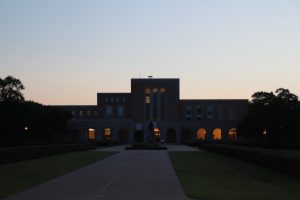
This is my first-time visiting America, and I have often heard that everything is big in the U.S. and this was true. Especially at the grocery store I noticed that the packages of every food were big. For example, milk was sold in a half gallon bottle. As far as I know, gallon bottle is only used for chemical reagents such as Acetone in laboratory in Japan. It’s a difference of the culture, people in the U.S. buy a lot at the same time and they don’t make as many trips to the grocery stores. The other thing I noticed was that the area for organic vegetables was very big. In Japan, I rarely see this in a normal grocery store. As this is the only solution for stopping the war of pesticides and insect for now, it’s nice to see it widely available in the U.S.. I think Japanese people should learn from this.
On August 16 and 17, we went to Rice University and enjoyed a tour of campus and took a couple of seminars. The design of buildings was integrated and it looked conventional and warm. There are also many trees and we could find many squirrels. I’m really excited to study at such a beautiful campus for the next month. In a presentation provided by Sarah on August 17, we learned about the differences of class room culture and that was interesting for me. American classes are interactive and students can ask question at any time. In Japan, basically a class is just from teacher to students, but actually, I have experienced classes like in the U.S. It was in my high school age, and a class for the university entrance examination. In my high school, there were only three people who were going to take the exam at Tohoku University, so in the class room, there were only three students! I could ask any question at any time, and sometimes I told jokes, too.

These classes were most enjoyable ones in my life, but I think I could act like that because all students there were close friends and the atmosphere was so comfortable. I envy U.S. students because they can take this kind of class all the time! In Japan, I feel a bit nervous asking questions while in class when there are hundreds of students are listening to the teacher.
This weekend, I went to a major league baseball game and saw the Astros V.S. Athletics. As Astros is a team of Houston, it seemed that all spectators were Astros fan. The fans are really hot, they looked very glad when an Astros player did a fine play, but also booed when they made a bad play. There are many directions in the stadium which amuse spectators. I enjoyed singing “Take me out to the ball game”!
Preparing for Research in the U.S.
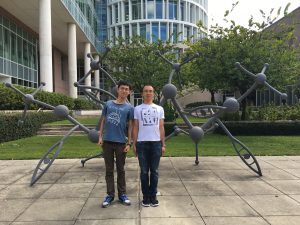
While in Japan, I contacted my host lab professor, Prof. Zachary Ball, and my mentor Jun Ohata. I received a paper which about the project I would be working on during my internship. The paper was about a reaction of the protein’s modification catalyzed by a transition metal. As my major is biochemistry (especially biology), I’ve taken a couple of classes on proteins but transition metals were completely new for me. I read a textbook on organic metal synthesis chemistry and learned about it’s fundamental theory. I also tried to remember 20 amino acids, as their English pronunciations are different from Japanese ones. It took time to get used to them.
So far, I’ve spent a couple of days in the lab, and found that my preparation was not enough. I really don’t know the pronunciation of many technical terms in English, although it’s indispensable for research in the U.S. My advice for future Japanese students is to remember the English pronunciation of fundamental terms in your major. In Japan, the pronunciations of scientific words are often mix of German and English. For instance, in chemistry, you should remember at least the pronunciations of the functional group and major reagents. It feels so regretful when you can’t understand a term that was easy for you in Japanese.
Question of the Week
What do people in the U.S. think of organic vegetables? For what reasons do they choose organics?
- Organic vegetables are believed to be healthier/safer because they do have pesticides. The popularity and availability of organic vegetables has increased rapidly in the past 20 years and some people will only purchase organic items. However, they can be much more expensive than regular options so not everyone can afford them and some people feel that as long as you carefully wash your fruit and vegetables it is okay to buy regular food. People have a wide range of opinions on whether it is worth it to buy organic food or not but they continue to grow in popularity and there are grocery stores like Whole Foods Market or Trader Joe’s that focus on organic and other specialty food such as gluten-free, non-GMO, etc.
- Other people focus on buying locally produced food since the food you buy at grocery stores in the U.S. is often shipped long distances across the country and/or imported from overseas. Buying local means you help reduce carbon emissions since the food doesn’t have to be transported so far and it is often fresher and tastes better because you buy what is in season. People who want to buy locally produced food will do a lot of their shopping at Farmer’s Markets such as the Rice Farmer’s Market that is every Tuesday evening. Most cities/towns in the U.S. now have multiple farmer’s markets to choose from but you need to consult Google-sensei to find out when and where the farmers markets are in your local area because usually they are just one day per week.
- Organic Food is Pricier, but Shoppers Crave It: https://www.usatoday.com/story/money/2017/07/27/organics-popularity-higher-than-ever-43-billion-2016/500129001/
- Kroger’s Organics are Threatening Whole Foods’ Popularity: http://www.slate.com/blogs/business_insider/2017/03/27/kroger_s_organics_are_threatening_whole_foods_popularity.html
Week 02: First Week in My Research Lab at Rice
On the first day in my lab, I had an initial meeting with my mentor and professor. After I gave them my souvenirs from Sendai (green soybeans rice cake called zunda-mochi) and we had a brief self-introduction, we started talking about my research project and they gave me overview of the research in their lab. The professor was very busy so the meeting with him was brief, but it was good to know the overview of the project on the first day.
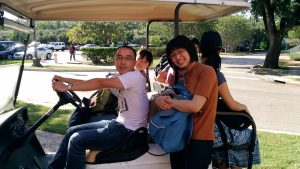
Jun Ohata is my mentor and he is a graduate student who joined the lab in 2013. He is from Osaka, Japan and he came to Rice after his completed his master course at Osaka Prefecture University. He is really kind, smart, humorous, friendly and strict. He works closely with me and always let me think about what I am doing and what is needed for the next step. I can’t imagine a better mentor than him! Our lab is located in the Bioscience Research Collaboration (BRC), a building which a bit distant from the main campus. So, at lunch time we often go to a restaurant on the main campus by a golf cart! It’s very interesting, and also gives me a thrill.
Though my mentor is a Japanese, we use English and speaking Japanese is forbidden in our lab. In a corridor or office, I can use Japanese and he suddenly switches his language. While in the lab, he often asks me to explain the meanings of the experimental process. Every time I feel my lack of the knowledge on chemistry and English vocabulary, and it’s hard to express in English even about matters which I understand. Jun knows which English words I can’t understand, because they were also ones he could not understand in his first year in the U.S. It is very helpful for me that he doesn’t hesitate to use the words but also explains to me after he has said. I’d like to learn a lot under him through this internship.
Also, during this week, we had a couple of seminars organized by Nakatani RIES program. On Tuesday, August 22, we had a seminar about poster design and development given by Dr. Gayle Moran, who is a Lecturer in Professional and Engineering Communication at Rice. She gave us a lot of specific tips such as how many words should I use, how to use bullet lists, and so on. As this is a first time for me to make a research poster and do a poster presentation, it was really helpful. The poster session will be held at September 20. One thing I’m worried about now is how can I make my presentation easy to understand for people who are not majoring in Chemistry. During the seminar, Dr. Moran asked my research topic, and my explanation was too specific and she could not understand. I decided to think of a concise and clear title for my poster and how to avoid using or explain technical terms since this seminar.
On Thursday, August 24, we had a seminar on “Strategies for Vocabulary Acquisition” by Kyung-Hae Bae, the Associate Director in Center for Written, Orla, and Visual Communication (CWOVC). She told us about specific methods we could use to acquire vocabulary such as the use of thesaurus and collocation dictionally. According to her, two things are important for acquiring vocabulary, “exposure” and “paying attention”. This internship is the best chance for my exposure to English, but I have been a bit tired asking questions because there are too many phrasess I don’t know. This seminar reminded me of the importance of not ignoring the English conversations around me but paying attention and asking questions when I hear some new words.
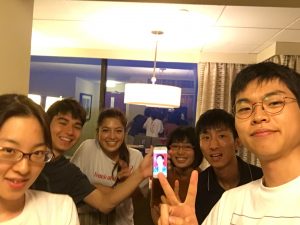
Actually, now it’s August 27, 2017, and a big tropical storm named “Harvey” stays near me. The roads became like shallow river and I can’t go outside of my hotel. Harvey once became a Hurricane and made landfall in Texas as Category 4 Hurricane in what officials have warned could be a “major disaster” for the US state and surrounding areas. Fortunately, it got weaker before it came to Houston and now it’s a tropical storm. However, this is still the same as “strong typhoon” in Japan and all of the rain has caused this situation now. We are enjoying our time inside by watching movies and having dinner party, but it was announced that Rice will close until Wednesday, I hope to get out soon!
Research Update
The topic of my research project is to develop a new protein tag for purification and modification purposes. Agarose beads, nickel, ligand, and tag are used for purification of a protein. In the preceding research, a tag consists of 6 amino acids (Hexahistidine tag) was used to modify the protein which they wanted to purify. On the other hand, this time, only two amino acids tag is used. My project is to find the best ligand which provide the best purity and efficiency with the small tag.
SDS-PAGE — the method to analyze proteins by their molecular weight is used to confirm the result of purification. It was really good that I experienced this before during an experimental class in my home university at last semester. However, as it was a team experiment, I didn’t remember the whole process. I should have done it more diligently!
This week I tested aminopyridine as a ligand, though unfortunately it didn’t have good activity. My next step will be the same experiment without the tag to confirm the necessity of the tag (negative control experiment) and then test of other ligands.
Question of the Week
At grocery stores, I often see fat-free milk or yogurt, and I heard that they remove fat to avoid people’s overweight. Is this right? I think too large sweet drinks are more problem!
Week 03: Interview with a U.S. Researcher
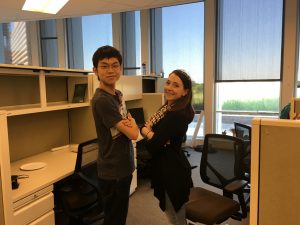
This week I interviewed a graduate student in my lab, Ms. Katie Miller. I decided to interview her because she was very friendly and has been so kind to me since I arrived.
She was born in the state of Alabama and came to Houston a year ago. After she received her undergraduate degree from the University of Alabama, she came to Rice for her graduate study to pursue a degree in Biochemistry. She once wanted to be a dietitian, but she started to be interested in why certain food is good for your health. She chose biochemistry for her major to get a deeper understanding for it. It was also because she experienced research in a chemistry lab when she was an undergraduate student and enjoyed it.
She said that she likes the good nature of her work environment at Rice and that the ratio of professors to student is small. In the Ball lab, basically only one person joins every year so there are about six graduate students in the lab. This is not usual in other big universities like at the University of Alabama so that’s why she decided to come to Rice University; to get an experience which was different from her undergraduate experience.
She also said that the nature of Ball lab is positive. Everyone is very supportive and they help each other. They work interactively and collaboratively rather than individually. She said that at the University of Alabama, each person in her lab had one project and usually nobody touched one another’s stuff. Everybody just did their own project there. She said that see prefers the nature at Rice rather than Alabama.
The ratio of gender at Ball lab is about fifty-fifty and they have two international students and one postdoc from Japan. Although she has not been to work in the another country, she interacts with a couple of international people at her lab and working internationally is her part of plan for future. Her future plans for after getting a PhD is to work as a postdoc for a couple of years and then work in industry.
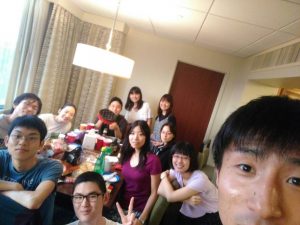
When I asked her is she had any question about Japan or me, she asked me “Are you still single?” It’s her funny joke, she is already married. She was curious about the system of Japanese graduate school, and she was surprised to know that in Japan, many students get only master degree and do not proceed to Ph.D. I explained this reason is that Japanese companies do not like to hire too specialized PhD students, she seemed to be amazed because in the U.S. the situation is opposite.
Through this interview, I could understand that Rice University does not show the typical U.S. university/lab nature in all aspect. As this is my first time to come to U.S., I could not recognize a character is common in the U.S. or only at Rice. Especially I thought that the collaborative working environment is common in the U.S., so it was surprising for me to know that it necessarily normal in the U.S.
Research Project Update
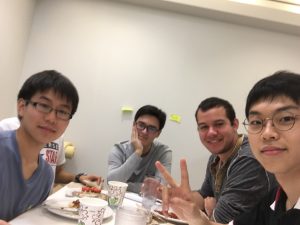
Throughout this week, I could not go the lab and do any research because Rice University was closed due to the after-effects of Tropical Storm Harvey. Instead, on Thursday Aug 31, I went to the Japanese Language Table Lunch with Ozaki-sensei (Japanese language teacher at Rice) and her students in one of the dorms at Rice campus. I ate lunch with 1st year students. They entered Rice just a month ago and have only had a couple of Japanese classes so far. That’s why they could only say “What time is it?” in Japanese. They seemed to be nervous when they spoke in Japanese, just like when I spoke English first time when I was a junior high school student. However, some students suddenly spoke certain Japanese word such as “Senpai” very fluently. It was because they watched Japanese anime. Many students start to study Japanese because they like anime and I felt it’s importance as a Japanese culture.
Question of the Week
Including Ms. Miller, three people in Ball lab are married. This is also the difference from Japanese graduate students. Is it common in the U.S., right?
- This varies a great deal by person and can also vary by region in the U.S. In more rural areas of the U.S., getting married quite young (even right after you graduate from high school) is not uncommon but in many larger cities or urban areas on the East or West Coast this is less common.
- Typically, there are two waves of when most people get married in the U.S. The first is right after graduating from college in their mid-20s. The second wave of people who get married usually happens in their late 20s or early 30s.
- Also, since many graduate students at Rice are PhD students, they may be older than the typical Master’s student in Japan and therefore closer in age to their mid-20s which is a common age of marriage in the U.S.
- However, just as in Japan, average age of first marriage in the U.S. is increasing and there are growing numbers of people who do not marry but do live together. There is not as much social stigma about having children as an unmarried couple or being a single parent in the U.S. either. So, overall marriage rates in the U.S. may also be lower than in Japan where it is not socially acceptable to have children until after you are married.
- Average Age of Marriage in the U.S.
- Average Age of Marriage in Each State
- How the Age People Marry Has Changed Over Time
- Historical Marriage Status Tables
Week 04: Reflections on English Language & Life in the U.S.
One thing I struggled with in English is the “negative questions”, such as “Aren’t you feeling good today?” The answer for the question is the opposite in English compared to Japanese. If you are in a good condition, you say “no” in Japanese, but “yes” in English. I learned this in my English class in the junior high school and high school, but even if I understand its theory and can do it correctly in writing, I cannot do when speaking because it requires quick thinking. My mentor kindly asks me such kind of questions often and corrects my answer. Thanks to him, recently I started to be used to this.
The other thing he often pointed out about my English is the response. As I’m not used to it in English, I didn’t have much repertory, so I often used “Uh-huh” as a response in conversations. Then he told me that I use “Uh-huh” too much in conversations, and he taught me that it is generally means agreement, so not always an appropriate response to say, “Uh-hun, I made a mistake!” Now I always try to make an appropriate response in a conversation.
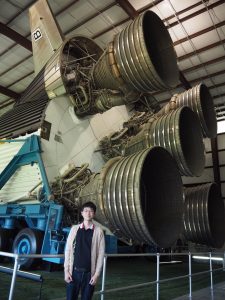
My technique to help my English acquisition is keeping a small notebook handy and writing down new words. As I can meet them anywhere, just a small notebook is good so as I can keep it in my pocket. I ask the meaning of the word to people or consult a dictionary later.
This weekend, I visited two interesting places. On Saturday, I visited Space Center Houston (NASA). From space suits, to spaceship, to the control room, to the training center for astronauts – I saw a lot of amazing stuff! However, I couldn’t see few people working there, because it was on Saturday. This was also a holiday weekend for people who work in NASA except for those working on a busy deadline/project. However, by hearing about the hard training for astronauts, I could feel the passion for the space that people who work at NASA have.

On Sunday, I went to San Jacinto to see “Battle Ship Texas”. She is an old ship made about a hundred years ago, but also worked in the Iceberg operation in Okinawa during World War II. (It is interesting to use “she” to a call battle ship.) She became part of a park after her retirement. Most parts of her are open to the public and I could enter the first and second decks. On the second deck (inside of the ship), I could see many beds for the over thousand person crew that would be on board for a voyage. It was surprising that there was also a barber shop, a small grocery store, and a tailor. They said that in the tailor, the crews could order gifts for their wives or girlfriends. Even though there are such kind of facilities, it seemed still too hard for me to cross the Pacific Ocean, because there were only twelve restrooms for over a thousand people and it would roll a lot while a voyage. I really respect the vitality of the people belongs to Navy.
Research Project Update
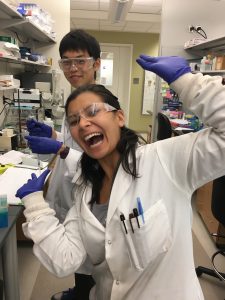
This week, Rice University re-opened, after being closed due to Tropical Storm Harvey for one week, and I was able to return to doing research. It was good for me that the last day before the university closed was a Friday so I got a full day of research in that day. As I wrote in the end of my weekly 2 report, I started from the negative control experiment, to confirm the necessity of the tag in the process of the purification of a protein. Unlike I had expected, without the tag, I had some yield of the protein. It seemed that to the beads used in this experiment, the protein sticks a bit non-specifically without the tag. Simultaneously, I tested a new ligand, 4-aminopicolinic acid, and found that it had a good selectivity for purification. After getting these results, I decided to try different buffers for the protein solutions, expecting for a buffer which does not make non-specific binding between the beads and protein. On Friday, I got the result of the research and I could find a good buffer. It will be the final experiment that by using that buffer testing a couple of ligands for purification on next week.
Weekly Question
What is a good response to show that I am listening to a conversation, except for “Uh-huh?”
- Good question. Remember the importance of eye contact in the U.S. In countries like Japan, it is more common to make verbal confirmations like “so” or “hai” throughout a conversation with someone so that they know you are listening/paying attention.
- While we do use comments like “mmhmm” or “uh-huh” when talking in English, comparatively, we use less of them as we are expected to be making eye contact with the speaker so they know we are following what they are saying. You don’t want to keep direct eye contact the whole time they are speaking, that can be too intimidating even to an American, but a mixture of eye-contact, nodding your head, and occasionally saying “mmhmm” or “uh-huh” is fine.
- Also, students in the U.S. are discouraged and taught not to use filler words like ‘so’ and ‘hmm’ when giving presentations from the time they are in elementary school up through college. So, many people try not to use words like “mmhmm” or “uh-huh” too much in everyday conversation because then it becomes a bad habit that is hard to break when giving a presentation.
- You might want to pay attention to how other graduate students in your lab converse with each other to get a sense of the timing for this in English; particularly if it is two Americans talking to each other. This does vary by person a bit though and unfortunately there is no set rule. This is something you just have to learn over time by living/working in an English-speaking environment.
- Why is Eye Contact Important During Conversation
- The Impact of Eye Contact
- 10 Reasons Eye Contact is Everything in Public Speaking
Week 05: Research in the U.S. vs. Research in Japan
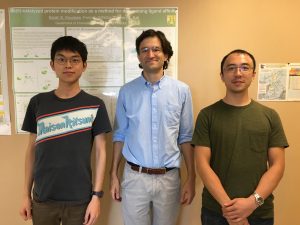
There was no significant gap between my expectations and my research experience in the lab. As Sarah and Kono-sensei mentioned in the orientation before the start of research, my work in the lab was mainly to assist with the research. However, to understanding my project and making good questions/suggestions to my mentor was more difficult than I had expected. It required significant understanding of chemistry.
There were not so many rules in the lab. For example, the working time of people is up to each person. The atmosphere of the lab looked very free to me, but the professor strictly required good results. I attended the lab group meeting a couple of times. During the meeting, students provided a presentation about papers they were interested in. Professor Ball often made striking and critical questions to students, and many times they struggled to answer. I thought that it was really good training for students so that they can be competent. They will be used to chemistry questions and they will be able to answer the questions at a scientific meeting. It was also impressive for me that a couple of first year graduate students or undergraduate students attended. The graduate students are now considering which lab they’ll belong to, and the undergraduate students were doing research in Ball lab.
One interesting anecdote that describes the Ball lab well is that the project my mentor is working on now is called “a submarine project” because he started it without telling Professor Ball. And he conducted the research secretly over a couple of weeks. It’s like a submarine that is hidden in the ocean, so people in the lab called it a submarine project. The interesting fact is that Professor Ball finally approved it and the research led to a paper being published in a good journal. Actually, my project also has its origin as a submarine project.
I’ve not decided my future plan yet, such as which graduate school I will go, but it was a very good opportunity to know how labs work in the U.S. and what I need to learn more to be a researcher in the U.S. I will decide my career plan after I entered into a lab at my home university in my senior (B4) year, and graduate school in the U.S. is a possibility for me. I’d like to study English harder so that I can choose any way I want in the future.
On Wednesday, I went to see the tenure talk by Dr. Laszlo Kurti, an associate professor in the chemistry department at Rice University. According to my mentor, it was a special tenure talk because usually it’s done when an assistant professor becomes associate professor. In this case, he was already an associate professor. His presentation was highly sophisticated. It was over an hour but he talked really fast, and the talk was about organic chemistry. It was a high-level chemistry talk and I could not understand everything; but it was remarkable for me that he tries to reduce the use of metal in chemistry (also in industry) to make it more sustainable and safe for the environment. I thought that it was great to make such kind of event open to students. The seats in the first row were occupied by professors in chemistry department, but it was amazing that I could sit down right behind them, in the second row! Although I could not understand specific reactions, I could know how hard do I need to study and how much chemistry can affect the world.
Final Week in Lab
By the last week, though I made a couple of minor mistakes, my research was successful. However, the experiments this week showed results which were completely different from our hypothesis. More specifically, the beads were supposed to be blue because it catches nickel, which has blue color, but it remained white and the other beads that were not supposed to be blue became blue. We guessed what caused the results, but there was not enough data to figure them out. It could be my mistake, degradation of the beads, or the effect of other reagents. I wanted to confirm what brought that results, but as this was the final week, I didn’t have enough time for this. I learned from this experience that it is very important to observe sample well (in this case the color of the beads), and be cautious enough to believe my data.
My mentor and other lab members helped me with designing my research poster a lot because it was my first time to make one. I could enjoy designing my poster and demonstrating its explanation with lab member. Next time I make a research poster, I’d like to remember how I made it in this time.
Question of the Week
I heard that many people usually visit during a tenure talk, although this time there were about 40 people in the room. In general, how many people visit a tenure talk and who decide that the speaker can get tenure or not?
- At Rice University, having 40 people attend a talk is a very good turnout. Remember, that Rice is a small-to-medium size institution and so it’s not very common that you will have hundreds of people in a room; anywhere from 20 – 25 and above is usually a respectable number for Rice.
- Attendance really varies by speaker, topic, and timing. For example, if the talk is held at a time when students are in classes then fewer students are likely to come. Or, if the talk is held during an exam period, such as mid-terms or finals, then again, fewer people are likely to come.
- How many people show up is also dependent on how well-advertised the talk is within the department or campus. Many departments only send out information on talks and events like this via email lists to students, faculty, and staff but sometimes students don’t read these emails carefully or just delete them all without reading (because they think they are not important).
- This is why, as a graduate student or undergraduate student at a U.S. university, it is important to read all emails that you receive as you might learn about special opportunities and talks that you otherwise would not have known about.
Week 06: Final Week at Rice & Research Poster Presentation
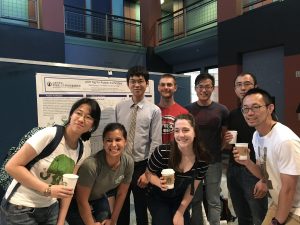
September 20, we participated in a poster session to present our research at Rice. Three professors from different universities who are potential host professors for the Part II research internship program came to see and evaluate our poster presentations. They carefully listened to my presentation, gave me nice comments, and asked me insightful questions. As I had practiced poster presentation many times with my mentor, other lab members, and other Japanese fellows, I did not struggle answering any questions I was asked in this poster session. However, one thing I noticed is that I was asked the same question a couple of times. It was about a requirement for the explanation of images. It was what I omitted because I thought that it was too detailed and there was not enough space. Although I thought so when I made my poster, the fact that many people asked it means it needed to be on the poster. I’d like to be sure to put such information on my research poster in next time.
Before the poster session, I asked Sarah about what is a good joke in a poster session and got an answer that a joke relates to my research topic and help to understand it is good. By following this hint, I prepared a joke with my mentor. It is a metaphor that compares the protein purification process to a story with a girl and prince charming. I used this joke to some female audience by changing “a girl” to “you”, and they laughed a lot. I believe that it helped their understanding to my research and that strategy worked successfully.
I was really glad because all the graduate students and postdocs in my lab came to my poster presentation. I explained about my research to them in detail, and it seemed that they enjoyed the presentations by other Nakatani fellows too. After the poster session, I went to a BBQ restaurant with them and enjoyed a final group outing and dinner in Houston. It was really lucky to be placed in such a friendly lab!
Final Research Project Update
My host lab was the Ball Research Group in the Department of Chemistry. My host was Prof. Zachary Ball and my mentor was Mr. Jun Ohata, who is a 5th year graduate student.
My project in the Ball lab was “pGH Tag for Protein Purification” (PDF). It is the purification of protein using a new tag strategy. Protein purification has become an inevitable tool to isolate a desired protein, and you need to isolate a protein to know it’s function.
Tag purification is now one of the most common ways to “pull down” desired protein. His-tag, GST-tag, and MBP-tag are examples of protein tag. Despite the usefulness of these tags, however, they require at least 6 amino acids, or could be as long as a few hundred amino acids.
In this research, we have developed a new dipeptide tag, pyroglutamate-histidine tag, which we call “pGH tag”. Taking a hint from purification for His-tagged protein, we have designed a purification process of pGH protein. First, “loading” of protein mixture to nickel beads allows them to bind to the bead. Because of stronger binding of pGH-tagged protein, we hypothesized that other weakly bound proteins can be removed by “wash” with imidazole. And finally, the desired tag protein can be obtained by “elution” with EDTA to take out nickel from the beads.
As for our methods, first, I have prepared nickel beads and pGH-tagged lysozyme by using a couple of reactions. I mixed the pGH lysozyme with other two proteins, ovalbumin (OVA) and trypsin inhibitor I (TII). After the loading, wash, and elution process, the final eluted solution was analyzed by gel electrophoresis.
Consistent with our hypothesis, the eluted solution contains pGH-tagged lysozyme in pretty good yield. However, negative control experiments with benzylamine or non-pGH-tageed lysozyme also showed the presence of lysozyme in the eluted solution. To solve this, I have performed buffer screening. Fortunately, I have discovered that use of PBS buffer dramatically decreases the non-specific interaction compared to other buffers.
So, in conclusion, I have demonstrated purification of pGH-tagged protein. I found use of a different type of buffer helpful to address the problem of the nonspecific binding. Future work will focus on production of another pGH-tagged protein to show generality of the presented method.
Week 07: Visit to Washington D.C. and New York City
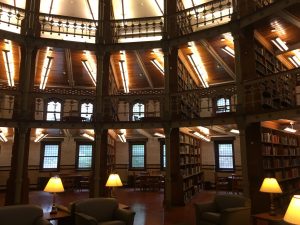
On September 21, we left Houston and arrived at Philadelphia. As this internship is my first trip to the U.S., Pennsylvania became the second state I visited in the U.S. Compared to Houston, the atmosphere of the city was more traditional. Especially in a city Bethlehem, where Lehigh University is located. The view in Bethlehem was like Europe. Lehigh University also had a lot of historical buildings. My favorite was the Linderman Library. It is an old library and Lehigh has another new and main library. Linderman Library is now used to store historical books and it is a place for students to study. I envy Lehigh University students because they can study in such a beautiful and historical library.
At Lehigh, we had a couple of seminars. One was a panel discussion about the research culture in the U.S. with professors at Lehigh. In the panel discussion, I learned that having a special interest in the major area is necessary to seek a Ph.D degree. The professors said that you should not to apply to a university, but to a specific laboratory. I think that the same thing can be said even in Japanese graduate school. Although I have not decided which graduate school I’ll apply to, I’d like to consider my special interests and choose not a university but a lab in the future.
On September 24, we came back to Japan and on the next day we had a closing ceremony at Sysmex Techno Park. We had a tour to look around medical engineering laboratoryatn Sysmex. Its office and lab was open and it was in part similar to the lab at Rice.
My initial thoughts on coming back to Japan, especially to Sendai was that it’s cold in morning and at night! Everybody complains about the hot climate in Houston, but I thought that its warmness lasts morning to night prevented me from catching a cold. Like that, I’d like to find good points both Japan and U.S. by comparing them from now.
Question of the Week
In Houston, I saw no racial discrimination at all. I guess it’s the diversity in Houston is reason for that. Are there a relationship between racial discrimination and diversity in the U.S. cities?
- For more on this topic see the section on Discrimination and Inequality in the U.S. on our Life in the U.S. resources page.
Final Report & Tips for Future Participants
Through the Nakatani RIES program, I learned about the difference between English in textbooks and in in real conversation. During my stay in the U.S., I heard many new words or phrases that I hadn’t learned in textbooks. Especially in the lab, I needed to remember a lot of chemistry words and experimental words such as fume hood, volatile, arbitrary, elution, aliquot, etc. It was really good that my mentor was Japanese, and told me such words a lot. These words have become my property now because they are very common and useful, it would help my next lab life in the U.S.
In terms of the research, I also learned a lot of things and it became a really good experience to be a young researcher. I learned that understanding a research project perfectly is not easy. Before this program, I’ve never been about to conduct an actual research project, as opposed to conducting training experiments. Although I read a paper published by my mentor that was related to my project in Ball lab in the first week, I struggled to understand my research project because it was in part similar to the paper but on the other hand different from it. I solved this problem by having discussions with my mentor over and over, and finally, by drawing the scheme of the experiment – then I could finally understand it. One thing I regret is that during this internship I got less independence and a lot of help from my mentor. For the next time I conduct research, I’d like to understand the project earlier because a good understanding of a research project is necessary for catching up with ideas and conducting research independently. I’ll also draw the research scheme as soon as possible, because it proved to be useful for my understanding. Also, in the experimental class at my university that I will take the following semester, I’d like to think by myself as much as I can and would like to prepare for conducting a research independently in the near future.
The students at Rice University looked very different from students in my university. I’d like to compare U.S. students and Japanese students majoring in chemistry. In Japan, many students set their goals to get a job in industry or the government after they receive a master’s degree in graduate school, so just a few people proceed to a doctoral course to seek Ph.D. degree. That’s why students who have strong enthusiasm in science who are conducting research, such as the participants in this program, are regarded as a peculiar person; especially among undergraduate students. In my idea, Japanese undergraduate students seem to have stronger passion for their club activities or part time jobs. By contrast, at Rice University, all the graduate students sought a Ph.D. and It seemed that they really like chemistry. I felt their passion for chemistry even from the undergraduate students. It was very surprising for me that some sophomore and junior students belonged to a laboratory and participated in research.
In the U.S., I felt that communication was indispensable. I learned about “elevator talks”, have a short conversation with strangers in an elevator many times while in the U.S. I think it is a really a good thing that people are very friendly and talk even though they are not friends. However, at first I struggled to start talking by myself because in Japan, it is not so needed to talk as compared to the U.S. and I was not used to talking with strangers in such situations.
Also in the lab, there were a meeting every two weeks and students were required to talk a lot. My lab members also communicated with each other while in the laboratory and the office, and it made the atmosphere really good. I could understand why a TOEHL iBT score is required for a Ph.D. course applicants in many U.S. universities. It is because communication is necessary in the daily life in the U.S. and students must describe their opinions or plans for their research in English. One thing I’ll definitely do as a result of my participation in this program is to study English harder. I’d especially like to practice the communication in English.
Advice for Future Participants
My advice for future participants in the Nakatani RIES Fellowship for Japanese students is to prepare for research as much as you can; soon after you got to know your host lab. In my preparation, I chose to study new things, transition metals, however I should have started from studying what I already knew because I struggled to understand what I know in Japanese as I didn’t know the English technical terms. It would be good preparation to read textbooks on such areas. There is not “enough” preparation, however, the harder you prepare for your research, the more your summer will be a great experience.
Follow-on Project
I’d like to give an information session on science & engineering opportunities and international research to a high school in my hometown. Since I was a first-year student at my university, I help provide a presentation for students in my home high school about my university-life every year in an open campus event in my university.
It is possible to introduce this program and encourage high school students to study abroad in the open campus presentation, I hope students from my home high school will be a future participant in this program!
